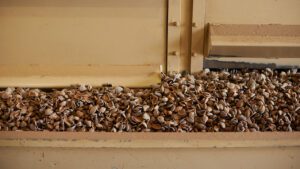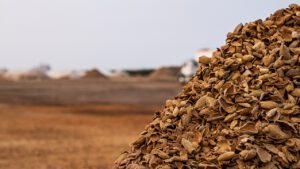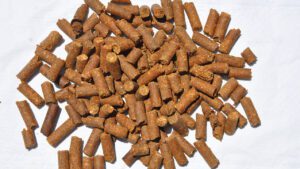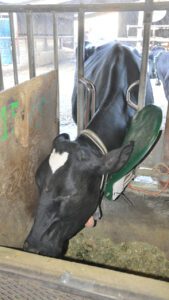
For decades, almond hulls have been a popular feedstuff mixed into the ration of dairy cows. Combined with the strong dairy presence in California, it has been mutually beneficial for both top agricultural commodities in the state.
This relationship has prompted questions of what other industries can take advantage of almond hulls, how the almond industry can ensure hulls remain a staple ingredient in dairy cow diets and how the almond industry can capitalize on these potential profits.
Proactive investment to explore these initiatives has been established by the Almond Board of California (ABC), starting with research in the poultry industry.
Feeding Hulls to Laying Hens
A study to introduce almond hulls into poultry diets was conducted at Mississippi State University under the direction of poultry nutritionist and associate professor, Pratima Acharya Adhikari. The goal of Adhikari and her team was to feed coarsely ground almond hulls to laying hens and analyze its effects on egg production and characteristics. Pullets were raised from day 0 and were fed almond hulls at 3%, 6% and 9% for 16 weeks before they began the laying hen study.
504 laying hens were studied in two phases: Layer 1 (22 to 42 weeks of age) and Layer 2 (44 to 70 weeks of age). The hens underwent seven treatments where they were fed 100 grams of feed, with increasing percentages of hulls in each treatment.
At the end of the Layer 1 study, Adhikari and her team began seeing a decrease in the yolk color, high amounts of albumen, which directly correlated to freshness, and variations in shell weight depending on the percentage of hull inclusion.
During the Layer 2 phase, the research team did not balance the bird’s diet with additional energy and relied solely on the hulls. This resulted in low production levels, especially in Treatment 7, where the highest level of hulls was present. Seeing this trend, the researchers shifted the feed formulation during the last six weeks of the study to meet energy requirements.
The team concluded from 22 to 44 weeks of age, feeding a diet of up to 15% almond hulls can increase production and egg weight as well as albumen height, and creates a better feed conversion rate and feed intake. In late-laying hens, it is recommended to feed up to 5% of hulls without any negative effects on production.
All this to say the ideal percentage of almond hulls fed to laying hens without negative effects greatly depends on the stage of the hen’s life. Hulls also should not be fed to hens without meeting their energy requirement and should not be the sole source of energy, Adhikari noted.
This research is the first of its kind, so Adhikari advised that the next step would be to research ways to increase the digestibility of amino acids and energy in the hulls. She also recommended testing prime-type hulls to determine if the outcome would be different.

Cubed Hulls/Alfalfa for Dairy Cows
On the other hand, there is extensive research proving almond hulls to be valuable in ruminant diets, but there is still work to be done to discover how they can be mixed in with different feedstuffs to maximize nutritional value.
During a 2021 study, Dr. Katherine Swanson and the team at UC Davis took four different qualities of alfalfa (low, medium, low-medium, high) mixed with four different quantities of almond hulls to find the optimum combination for digestibility and fermentation. The hope was to determine the strengths of each product to develop new innovations that could lead to additional markets.
“We found that by adding even as low as 25% hulls to our low-medium- and medium-quality alfalfa, we could get the same rate of fermentation and digestibility as our pure, high-quality alfalfa that’s typically fed to dairy cattle,” Swanson said.
Based on those results, the team decided to pursue further research analyzing apparent digestibility, palatability and production levels in dairy cattle being fed cubed alfalfa/almond hull mixes using a medium-quality alfalfa and varying percentages of almond hulls.
Over nine weeks, high-producing, lactating dairy cows were fed alfalfa cubes containing 0%, 20% and 30% almond hulls using a Latin square design, meaning the cows switched diets every 21 days to ensure each cow consumed every diet.
The data was collected within the last seven days of the 21-day period, and the team measured feed intake, milk production, metabolic markers using blood samples and collected rumen fluid to assess changes in their volatile fatty acid production.
Swanson said they did not see any significant differences in feed intake or milk production between the trials, but the biggest variation between this study and the 2019 study, where dairy cows were fed increasing levels of hulls, was digestibility levels. Using data collected from rumination collars, they found that the cubes with 20% almond hulls had the lowest overall digestibility.
“The cows spent the most time per day ruminating which makes sense if things are less digestible,” she said. “They needed to be chewing more, and the feed spent more time in their rumen being broken down and fermented.”
The cows consuming the 20% cubes also had significantly higher fat percentages in their milk compared to the cows consuming no hulls, Swanson added.
Swanson and her team concluded dairy farmers who elect to feed lower-quality alfalfa to milk cows can still meet high levels of production by adding 10% to 20% almond hulls into the cow’s diet.
“Consuming a diet that is a little bit lower in almond hulls will really help those cattle to better utilize lower-quality alfalfa without having a huge negative effect on digestibility,” Swanson said. “Even with that drop in digestibility, it was still supporting very high-level milk production as well as improving milk fat composition.”

Reducing Emissions Using Fermented Hulls
Nutritional value isn’t the only thing almond hulls can provide ruminants. Early studies now show fermented hulls may be a step in the right direction to reduce methane emissions produced by dairy cows.
Data show probiotic supplementation with yeast can have nutritional benefits and reduce enteric methane, which makes up 25% of U.S. methane emissions. While not all attributable to dairy cows, this led ABC to fund research to develop methods for producing high-quality fermented almond hulls and determine how they can be utilized by dairy farmers.
Dr. Hamed El Mashad and the team at UC Davis first experimented with placing different almond hull varieties of both dry and green hulls in vacuum-sealed bags with different temperatures and moisture contents. Their findings showed both dry and green hulls produced comparable fermented feed with similar characteristics.
Another study was performed by Dr. Matthias Hess, this time using in-vitro rumen fermentation with a hull inclusion rate of 20%, incubated for 72 hours. The results were very promising, showing yeast-fermented hulls reduced methane production by 96%.
Mashad explained more research is needed to support these claims, which would require scale-up fermentation processes with high-quality feeds and more in-vivo trials on cattle to assess the proper inclusion rate for their diets. Grant projects are in the works to provide more insight, he said.

Expanding Areas of Profit for Growers
ABC recognizes the importance of finding ways to repurpose almond byproducts, which is why developing innovations in the animal feed sector are top of mind, but there is also a need to scale beyond California.
Keith Schneller, ABC senior trade policy specialist, said they are also working toward expanding market access of almond hulls into China. Although the import protocol for almond hull pellets and cubes was approved in 2020 as part of the U.S.-China Phase 1 Agreement, work is being done to expand the protocol to include whole and ground almond hulls. As of late 2023, ABC was also working through the final steps to get hulls listed in the Chinese Ministry of Agriculture’s feed ingredients catalog, which is a prerequisite before Chinese importers can sell almond hull pellets and cubes into Chinese livestock feed channels. As soon as the hulls are listed in the catalog, there are already six California processors on China’s approved list who can start exporting to China.

Schneller acknowledged investment in new processing infrastructure will be necessary to comply with cube and pellet demands, but based on feedback from exporting partners, it is a favorable opportunity for the almond industry.
“A lot of the potential overseas buyers, when they hear about some of this research that the industry is doing, they’re really excited,” Schneller said. “Hopefully with the growers, it’ll really pay off.”















